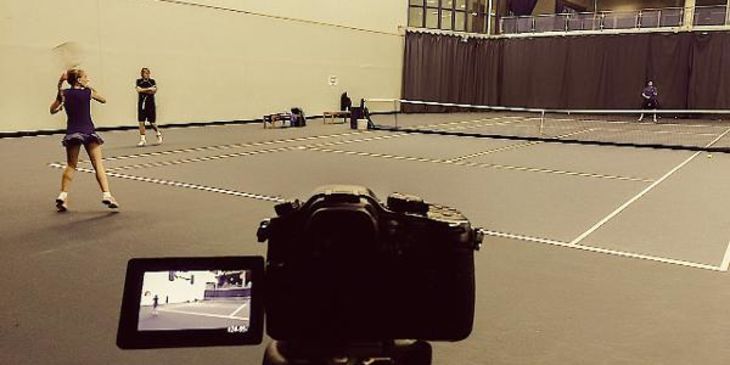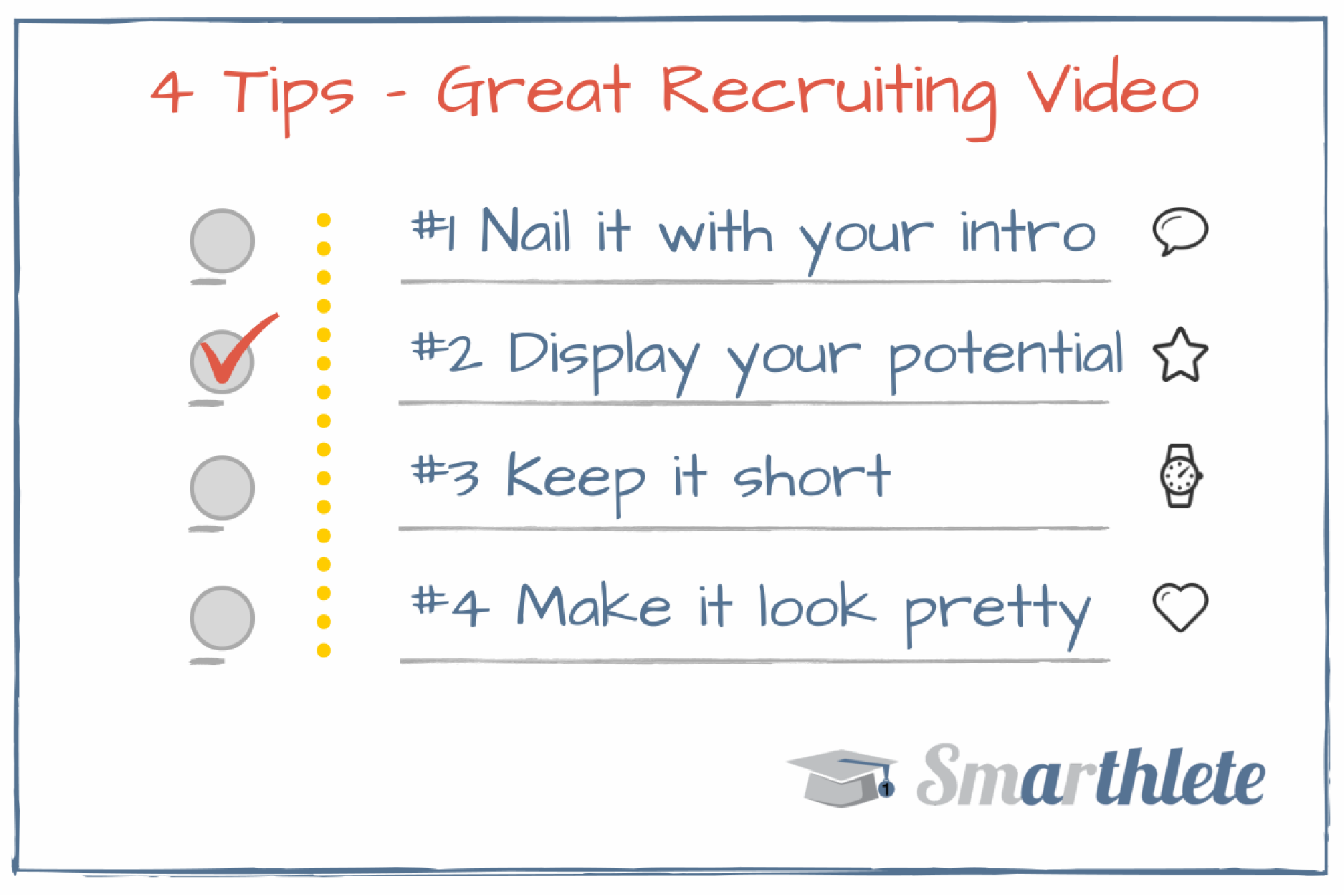How to Produce a High-Quality Recruiting Video to Get a College Tennis Scholarship

No matter how strong of an athlete you are, to a college coach you're still just one of many names in the beginning. Depending on the sport, a video of your technique, skill level, and game plan will be highly relevant to make it on the short list of an interested coach. Today's Friday Scholarship Guide is for tennis players, who aspire to play college tennis and who will certainly be faced with producing a high-quality video quite soon.
1. What coaches need to see
Tennis college coaches always keep their eyes open for potential recruits. They do so every day no matter if they're in the middle of the playing season or sometime else during the year. They have their assistant coaches look at players, they do some of the job themselves, and they have other outside contacts recommend athletes. The number of athletes, contacting them each day is high, but coaches generally look at all potential leads they hear of. They want to be sure not to miss out on any interesting players and the larger the pool of people, the more likely some player will be out there, who fits in their team line-up.
Tennis offers one great advantage over many team sports: ranking points in national or international rankings indicate your individual strength to the coach. This may be fairly easy if you have results in international under-16 ETA tournaments or under-18 ITF events. Often, a coach will also have a good idea of your real strength depending on the country you come from. Obviously top 10 in the under-18 ranking in the U.S. is a lot harder to achieve than top 10 in a small country like Belgium.
But even though coaches can assess your level from your ranking, you're still just one of many talented players out there. You may have profited greatly from an amazing short-term winning streak last summer or your general physical advantage compared to your age peers. But coaches look for players to join their team for a period of four years. Do you have a game that has the potential to develop over time or have you reached your maximum already? Is there room for improvement of your weapons or are you likely to stagnate? That's why coaches take a closer look at your entire profile and benchmark you against their Recruiting Checklist. There's no better way to do so than seeing you compete in person or on video for starters.

Personality
You've heard of the phrase "first impression matters" right? Well, the same applies to recruiting and you have a small window of opportunity to present yourself to coaches in the beginning of your video. Think about how you'd introduce yourself to strangers and adjust it to the needs of coaches. What are relevant things they'd like to find out about you in around 30 seconds? It may be the only 30 seconds you get from coaches on a personal level before they make a decision whether to keep you on the shortlist or not. Read here, why coaches definitely look for tennis recruits who are a great fit to their team on a personal level.
Technique
In the highlight reel, coaches want to complement their impression of you as a tennis player. They have an idea of your strength based on your ranking and the people you've lost or won against in international and national tournaments. Maybe they have heard about you from another coach or player, which definitely helps in the recruitment process. What's missing is to see what you really can and can't on the court. Beside the technical elements, a coach will want to see an indication of your physical strength, in particular footwork, on the court.
Tactics
College coaches recruit you because they want you to win for their team. Great technique doesn't win matches alone, but it gives you the tools. With a tactical skill set and a good game plan, your profile looks a lot better. Coaches want to see you play and compete. They want to observe what they see in the practice part of the video in match situations. Show some match play against your practice partner, including serve and return games and coaches will get an idea of you as a complete player very quickly .
2. Producing the tennis recruiting video
Many people ask us how the video shall be recorded. There are a variety of possibilities, and some great firms have specialized in this part of recruiting. Check out some of their videos or consider getting some help. It can definitely be worth it.
(If you sign up with a Premium Recruiting Profile on Smarthlete, you will also get access to our recruiting video guideline!)
If you decide to do it yourself, have someone change the camera position: your strokes from behind, the side, and the front. In case you have an opportunity to place the camera somewhere higher up (seating grandstand for example), this could add greatly to your video.
Speaking of adding: The smartest way to get yourself into a good position with coaches is by setting up a free profile here at Smarthlete and adding your video to your recruiting profile. Coaches will love having all your information collected in one place. And find out in this article what other advantage comes with your video on Smarthlete here!
A general recommendation is to keep the video at an acceptable length. It won't make a difference whether you hit balls cross court for 4 minutes or for 8 minutes; coaches will see fairly quickly what they look for. A concise video will also make it easier for coaches to get a quick impression - you basically help them in their work.
It's a very good idea to produce the reel on the same surface on which college tennis competitions are played: hard court. Outdoors or indoors doesn't matter, but a fast surface the least is key. Some people wonder whether they should have their coaches hit balls with them. We would advise not to, as coaches are used to hitting balls "nicely" in order to put you in a good position. Instead, play with one of your hitting partners who's approximately on a level with you. This will give the most realistic reference point for the exercises and the match play in the end.
Presentation of yourself
Start with your name, where you're from, why you're producing this video, and what you want from the viewer. You can highlight some of your key strengths on the court, say thank you for the viewers' time, and invite them to contact you. We'd recommend you present yourself on the court just before you start your practice session.
Your skill set
Show all of your strokes in different exercises and positions. Nobody will want to see you play 15 backhand stops cross-court and then 15 forehand stops. Make sure you provide good footage of your forehand and backhand strokes, slice, volley, serve, and return. You can do so in different ways (down the line, cross court), but coaches will want to see you do it in action. Some young athletes are champions in hitting extremely hard when they get the balls during drills, but can they do so moving around on the court as well?
Game plan
In the end of the video, make sure you play points against your partner. We advise you to keep the camera in the same position without cutting out any parts. This might give the coaches the impression that you're trying to hide parts of your performance otherwise.
3. Editing the video
Here's an image of one of our other blog articles, which should help you in developing your recruiting video. You can also find the full article here: 4 Tips for Making a Great Recruiting Video

After you have done all the work on the court, it's time you edit the material to make it look awesome. Remember the video is one of the puzzle pieces for your ticket into college! There are standard programs on the large operating systems (e.g. Windows Movie Maker), which would definitely suffice for your requirements and do the job. If you need help, consider consulting someone who's done it before and can help you on.
Depending on your time and knowledge, you can make a lot out of your video. Some essentials which need to be in place though are the following:
- Sound quality
- Picture quality
- Smooth transitions when cutting
- Calm and steady position of the camera
4. Conclusion
Producing a video by yourself for the first time is all but easy. Give yourself time and expect that you might want to redo the practice session again to account for potential nervousness and inexperience. It's very normal you'll experiment around a bit where to best place the camera.
Finally, there's one last advice: college coaches look for tennis players who can really take the team to the next level not only as a player, but also as a person. In the video, show that you have a positive attitude on the court, good body language, and the willingness to work hard.
Create your free recruiting profile here with us at Smarthlete and upload your great highlight video right away! Coaches will have access to all the information you provide, including your personal recruiting reel. Get started now!